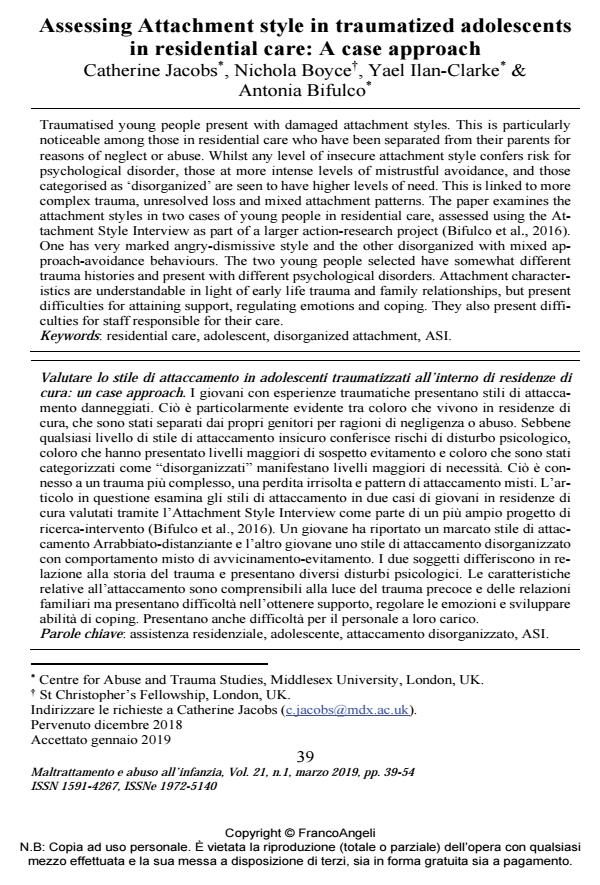Assessing Attachment style in traumatized adolescents in residential care: A case approach
Titolo Rivista MALTRATTAMENTO E ABUSO ALL’INFANZIA
Autori/Curatori Catherine Jacobs, Nichola Boyce, Yael Ilan-Clarke, Antonia Bifulco
Anno di pubblicazione 2019 Fascicolo 2019/1
Lingua Inglese Numero pagine 16 P. 39-54 Dimensione file 197 KB
DOI 10.3280/MAL2019-001004
Il DOI è il codice a barre della proprietà intellettuale: per saperne di più
clicca qui
Qui sotto puoi vedere in anteprima la prima pagina di questo articolo.
Se questo articolo ti interessa, lo puoi acquistare (e scaricare in formato pdf) seguendo le facili indicazioni per acquistare il download credit. Acquista Download Credits per scaricare questo Articolo in formato PDF

FrancoAngeli è membro della Publishers International Linking Association, Inc (PILA)associazione indipendente e non profit per facilitare (attraverso i servizi tecnologici implementati da CrossRef.org) l’accesso degli studiosi ai contenuti digitali nelle pubblicazioni professionali e scientifiche
Traumatised young people present with damaged attachment styles. This is particularly no-ticeable among those in residential care who have been separated from their parents for rea-sons of neglect or abuse. Whilst any level of insecure attachment style confers risk for psy-chological disorder, those at more intense levels of mistrustful avoidance, and those catego-rised as ‘disorganized’ are seen to have higher levels of need. This is linked to more com-plex trauma, unresolved loss and mixed attachment patterns. The paper examines the at-tachment styles in two cases of young people in residential care, assessed using the At-tachment Style Interview as part of a larger action-research project (Bifulco et al., 2016). One has very marked angry-dismissive style and the other disorganized with mixed ap-proach-avoidance behaviours. The two young people selected have somewhat different trauma histories and present with different psychological disorders. Attachment characteris-tics are understandable in light of early life trauma and family relationships, but present dif-ficulties for attaining support, regulating emotions and coping. They also present difficulties for staff responsible for their care.
I giovani con esperienze traumatiche presentano stili di attacca-mento danneggiati. Ciò è particolarmente evidente tra coloro che vivono in residenze di cu-ra, che sono stati separati dai propri genitori per ragioni di negligenza o abuso. Sebbene qualsiasi livello di stile di attaccamento insicuro conferisce rischi di disturbo psicologico, coloro che hanno presentato livelli maggiori di sospetto evitamento e coloro che sono stati categorizzati come "disorganizzati" manifestano livelli maggiori di necessità. Ciò è connes-so a un trauma più complesso, una perdita irrisolta e pattern di attaccamento misti. L’articolo in questione esamina gli stili di attaccamento in due casi di giovani in residenze di cura valutati tramite l’Attachment Style Interview come parte di un più ampio progetto di ricerca-intervento (Bifulco et al., 2016). Un giovane ha riportato un marcato stile di attac-camento Arrabbiato-distanziante e l’altro giovane uno stile di attaccamento disorganizzato con comportamento misto di avvicinamento-evitamento. I due soggetti differiscono in rela-zione alla storia del trauma e presentano diversi disturbi psicologici. Le caratteristiche relati-ve all’attaccamento sono comprensibili alla luce del trauma precoce e delle relazioni familiari ma presentano difficoltà nell’ottenere supporto, regolare le emozioni e sviluppare abilità di coping. Presentano anche difficoltà per il personale a loro carico.
Parole chiave:Assistenza residenziale, adolescente, attaccamento disorganizzato, ASI
- Understanding trauma in children and young people in the school setting Ruth Spence, Lisa Kagan, Moja Kljakovic, Antonia Bifulco, in Educational and Child Psychology /2021 pp.87
DOI: 10.53841/bpsecp.2021.38.1.87 - Incidenza e caratteristiche dei minori accolti in Strutture Residenziali in Regione Lombardia Sarah Miragoli, Ciro Cascone, Francesca Sgrò, Vittoria Badino, Luca Milani, in MALTRATTAMENTO E ABUSO ALL'INFANZIA 3/2024 pp.67
DOI: 10.3280/MAL2023-003005
Catherine Jacobs, Nichola Boyce, Yael Ilan-Clarke, Antonia Bifulco, Assessing Attachment style in traumatized adolescents in residential care: A case approach in "MALTRATTAMENTO E ABUSO ALL’INFANZIA" 1/2019, pp 39-54, DOI: 10.3280/MAL2019-001004